|
................ |
|
Often in response to a severe negative supply shock (such as an oil shock), inflation expectations rise quickly and the short-run Phillips curve shifts upward. Even after the economy's move northeast on the Phillips curve, policy makers are stuck with the short-run tradeoff between inflation and unemployment. If policy is contractionary to lower inflation, unemployment will rise even further. If policy is expansionary to eliminate the excess unemployment, inflation will rise even higher. In the long run the economy will end up back on the long-run Phillips curve with a high rate of inflation. What should the Federal Reserve do with regards to monetary policy in this scenario?
In the late 1970s the Federal Reserve faced just this decision. There is no good alternative for the Fed. Either they alleviate unemployment and live with higher inflation, or they cause a large recession and eliminate high inflation. The Fed opted for the latter which led to a deep recession in the United States. Unemployment peaked above 10 percent in the early 1982. However, in the long run (about six years after the 1982 recession), the economy had 3 to 4 percent inflation and was back to the natural rate of unemployment.
The overall point is that a leftward shift in the Aggregate Supply curve does not move the economy along the short-run Phillips curve, but it moves the economy to a point that is northeast of its present state. If inflation expectations increase, the Phillips curve shifts upward. Of course, a positive supply shock can shift the Phillips curve down as inflation expectations fall. Once either of these things happens however, the policy makers are still faced with the same short-run tradeoff between inflation and unemployment.
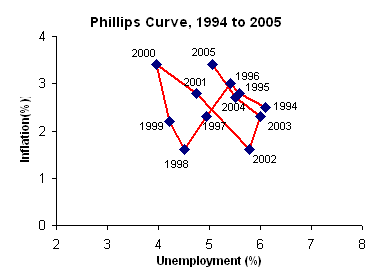 Despite being reconstructed in the 1970s, the Phillips curve threw economists for a loop again in the 1990s. During much of the 1990s, the Phillips curve relationship was suspiciously absent, as the figure titled "Phillips Curve, 1994 to 2005"illustrates. The economy's rate of unemployment fell, for example, from 7.8 percent in 1992 to 4.0 percent in 1999. Despite this decline, inflation did not rise much. In fact, in 1997 and 1998 inflation fell even further relative to previous years. Economists are not exactly sure why this happened, although lower oil and food costs played a significant role.
Despite being reconstructed in the 1970s, the Phillips curve threw economists for a loop again in the 1990s. During much of the 1990s, the Phillips curve relationship was suspiciously absent, as the figure titled "Phillips Curve, 1994 to 2005"illustrates. The economy's rate of unemployment fell, for example, from 7.8 percent in 1992 to 4.0 percent in 1999. Despite this decline, inflation did not rise much. In fact, in 1997 and 1998 inflation fell even further relative to previous years. Economists are not exactly sure why this happened, although lower oil and food costs played a significant role.
Another important factor explaining the odd behavior of the Phillips curve in the 1990s is labor productivity, or output per labor hour. (See Chapter 18, Economic Growth and Productivity.) Recall that one reason for the short-run trade-off between inflation and unemployment is that when unemployment declines, wage pressures increase, driving up prices. If productivity growth is high, however, firms can pay workers higher wages and still keep price increases modest becuase those workers are more productive. Productivity did begin to increase in the mid-1990s, and it has remained high through 2003. The surge in productivity is perhaps the key reason why wages and, hence, prices have not risen with the decline in unempoyment rates in the 1990s.
Similar to the 1970s, many economists are seriously questioning the usefulness of even the modified inflation-expectations version of the Phillips curve. The events of the 1990s indicate that, at the very least, the Phillips curve is not a reliable tool to forecast inflation. Indeed, some economists are discounting the supposed short-run relationship between inflation and unemployment altogether, arguing that the relationship is too volatile to be a reliable guide. No new consensus has emerged as of yet. Although many economists agree that the forecasting power of the Phillips curve is limited at best, they continue to believe that the Phillips curve does a fairly good job at explaining economic behavior after the fact.
|


 ) and unemployment is negative. When inflation rises, unemployment falls and vice versa.
) and unemployment is negative. When inflation rises, unemployment falls and vice versa.
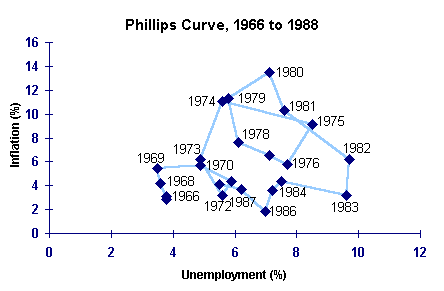
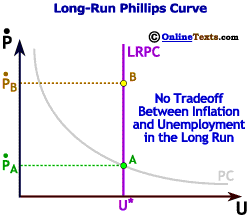
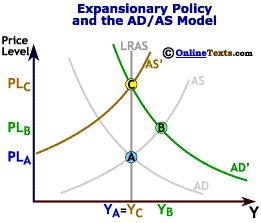
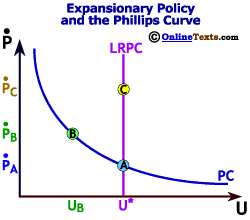
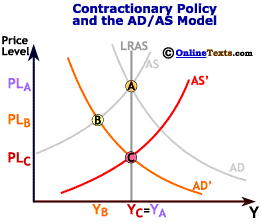
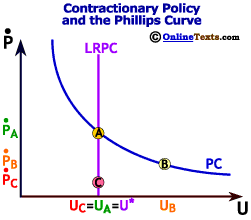


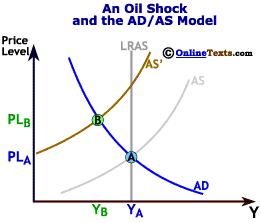

 Despite being reconstructed in the 1970s, the Phillips curve threw economists for a loop again in the 1990s. During much of the 1990s, the Phillips curve relationship was suspiciously absent, as the figure titled "Phillips Curve, 1994 to 2005"illustrates. The economy's rate of unemployment fell, for example, from 7.8 percent in 1992 to 4.0 percent in 1999. Despite this decline, inflation did not rise much. In fact, in 1997 and 1998 inflation fell even further relative to previous years. Economists are not exactly sure why this happened, although lower oil and food costs played a significant role.
Despite being reconstructed in the 1970s, the Phillips curve threw economists for a loop again in the 1990s. During much of the 1990s, the Phillips curve relationship was suspiciously absent, as the figure titled "Phillips Curve, 1994 to 2005"illustrates. The economy's rate of unemployment fell, for example, from 7.8 percent in 1992 to 4.0 percent in 1999. Despite this decline, inflation did not rise much. In fact, in 1997 and 1998 inflation fell even further relative to previous years. Economists are not exactly sure why this happened, although lower oil and food costs played a significant role.